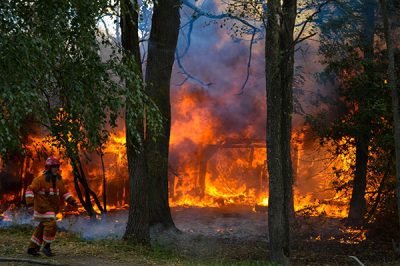How Prepared are Westchester and Putnam to Battle Wildfires?
News Based on facts, either observed and verified directly by the reporter, or reported and verified from knowledgeable sources.
 Last November, after weeks of drought, more than 130 brushfires in Westchester had county officials and residents on high alert.
Last November, after weeks of drought, more than 130 brushfires in Westchester had county officials and residents on high alert.
That same month a wildfire in Jennings Creek in Orange County burned over 3,500 acres; weeks before that, dozens of emergency responders battled a major brushfire in Kent, Putnam County, working around the clock for days.
Concerns about the risks of wildfires have intensified since the devasting California blazes that started on Jan. 7. Fires there are still raging, forcing tens of thousands of people to evacuate their homes and destroying more than 14,000 acres and 10,400 structures.
“We are getting inquiries from a lot of people because wildfires are on their minds right now as the California fires are still going on,” said Susan Spear, Westchester County’s Department of Emergency Services (DES) commissioner. “It’s a good reminder for local communities to be prepared.”
But are local fire departments and emergency services prepared for wildfires and brushfires in Westchester and Putnam counties?
The diverse topography in both counties ranges from densely-populated areas to more rural neighborhoods separated by vast forests. A wide variety of firefighting equipment is needed to battle different types of fires. Wildfires require small utility task vehicles (UTVs) that can easily reach areas difficult to access, such as forests where there are no roads. UTVs are equipped with lighter hoses, smaller water tanks, pumps, rakes and shovels. Additionally, firefighters must wear lighter jumpsuits when battling brush or wildfires.
If a fire department doesn’t have that special equipment, a mutual aid program connects them to neighboring departments that can share what is needed. DES often helps facilitate that connection. Spear said she and Neil Caputo, director of fire services and Westchester County’s fire coordinator, arrange mutual aid.
“If an incident is larger than an independent fire department can handle, we provide additional resources beyond what a local fire department has, and we can also offer them UTVs, technical resources and support,” she said.
Putnam County Executive Kevin Byrne said the county’s specialty and Hazmat teams often work with the Department of Public Works (DPW) when fighting wildfires.
“Our biggest struggle is creating a fire line when fighting wildfires,” Byrne said. “The DPW’s equipment, especially their excavator, has helped dig a fire line.”
Paul Liberatore, chief of the Yorktown Heights Fire Department, said his department received a grant a few years ago, enabling the purchase of a UTV specifically to fight forest fires.
“Along with the UTV, we purchased a forestry line, one-inch hose and a backpack to hold the hose and blowers used in brushfires in the woods,” he said. “The forest fire equipment is much lighter.”
Chief Gabriel Rivera of the Mahopac Volunteer Fire Department said his personnel work with the Carmel Fire Department and Carmel Volunteer Ambulance Corps to apply for joint grants to purchase new mobile and portable radios, which cost about $800,000.
“Compared to our low-band radios where we struggle with communication, these more robust radios would allow us to speak to other departments in neighboring counties, including Westchester,” Rivera said.
High-tech communication capabilities are essential to connect EMS agencies to boots on the ground. The Westchester Emergency Communications Center known as 60 Control provides primary dispatch services for 52 fire departments and 32 EMS agencies in Westchester. The center is staffed 24/7 to handle fire and EMS mutual aid. The Putnam County Bureau of Emergency Services also provides emergency assistance with its county-wide communications, which oversees the E-911 system.
Assessing what equipment is owned by various fire departments is the responsibility of New York State in its County Emergency Preparedness Assessment program (CEPA), which tracks county-level capabilities and potential gaps in preparedness.
“Every couple of years CEPA does a giant risk assessment for the county,” said Robert Lipton, Bureau of Emergency Services commissioner for Putnam County.
“The assessment sees what capabilities we have. They also do a risk analysis. That information is shared with other fire departments, the sheriff’s office, local police departments and ambulance corps. Everyone is asked for their input.”
Fire departments regularly apply for state and federal grants for funds to purchase the expensive, upgraded equipment.
“We always offer our assistance to fire departments and ambulance corps each year when they are filling out grants,” Lipton said.
Fighting wildfires takes different skills requiring special training, which is offered by state Department of Environmental Conservation (DEC) forest rangers.
But this type of training is generally offered only to career firefighters, not volunteers. Westchester’s 58 fire departments and Putnam’s 13 departments are overwhelmingly comprised of volunteers.
“Our firefighters usually spend a day at the fire academy hearing a lecture about wild land fire prevention,” explained Paul Eiden, chief of the Chappaqua Fire Department. “We’ve not seen a wildfire course offered, but I’m sure in light of what occurred in Orange and Putnam counties they will be looking to roll out a wildfire fighting course for sure.”
Rivera noted that there used to be wildfire training years ago.
“But it’s time to revisit and refresh,” he said. “Nothing formal has been set up but with last year’s brushfires we are going to do something.”
Wildfire preparation also includes being able to identify community-wide firebreaks and defensible zones. A firebreak is a narrow, clear area that acts as a barrier and prevents a wildfire from crossing to another section of land. A defensible zone is a wider area around a structure where vegetation is strategically managed to minimize the amount of flammable material near the building, allowing firefighters to access and defend the property more effectively.
Rivera said the Mahopac Fire Department familiarizes itself with the natural terrain by identifying what he called “high-target areas” using satellite imaging.
“Technology, such as common Goggle mapping, allows us to see the topography to identify areas and helps us know the lay of the land,” Rivera explained. “We can see which areas are accessible such as homes on the streets with backyards to where there are water sources.”
Extreme events that call on residents to evacuate their homes was recently addressed by Westchester County Executive Ken Jenkins who stressed the importance of being prepared in cases of emergencies, including fast-spreading wildfires.
“The devastating wildfires in California are a stark reminder of the need to be prepared to leave your home on very short notice during an emergency,” Jenkins said.
Identifying evacuation routes in emergencies is the responsibility of each fire district.
Spear joined Jenkins last week in urging families to have a plan in place if they need to evacuate their homes in an emergency and to always have a “Go Bag” with essential items ready to take with them.
“As an emergency is unfolding you want to have everything you need pre-packed so you can grab and go, if necessary,” Spear said.
Putnam County’s New State-of-the-Art Burn Facility
The Lt. Michael Neuner Fire & EMS Training Center is a new facility in Putnam County named after a firefighter who died in a residential structure fire in 1997. The facility opened last April.
“Our old facility was well over 10 years old and we had it demolished,” said Putnam County Executive Kevin Byrne. “It hadn’t been used for over a decade and was unsafe.” Training in the burn building uses real fire conditions.
“Firefighters can experience live situations such as fighting a car fire inside a smoke-filled building,” said Robert Lipton, Putnam County’s Bureau of Emergency Services commissioner.
The new center cost about $1.3 million and used funds from the federal American Rescue Plan Act. State Sen. Peter Harckham (D-Lewisboro) helped secure a $300,000 state grant and U.S. Sen. Kirsten Gillibrand and Rep. Mike Lawler (R-Pearl River) secured additional funds.
Publisher’s Note: An earlier version of this post listed an incorrect year for when Michael Neuner died in a residential structure fire. The correct year is 1997. We regret the error. This post was updated on the morning of Thursday, Jan. 30.

Abby is a seasoned journalist who has been covering news and feature stories in the region for decades. Since The Examiner’s launch in 2007, she has reported extensively on a broad range of community issues. Read more from Abby’s editor-author bio here. Read Abbys’s archived work here: https://www.theexaminernews.com/author/ab-lub2019/
